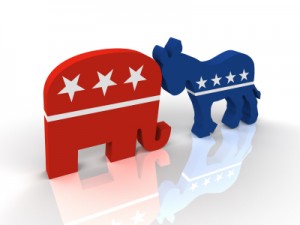This is part one of a five-part article.
Read Part II Here
Read Part III Here
Read Part IV Here
Read Part V Here
Part I. The New Politics
 High school civics classes for the past century have taught that America had a two-party system.
High school civics classes for the past century have taught that America had a two-party system.
And up until the end of the Cold War, this was true. Each party had clear, distinct values and goals, and voters had simply to assess the differences and choose which to support.
Such clarity is long gone today, and there is no evidence that this will change any time soon.
As a result, more people now call themselves “Independents” than either “Democrats” or “Republicans.”
We are led today by the contests and relations of seven competing factions, or parties. These major factions are as follows:
Republicans
1. Nixonians
2. Reaganites
3. Populists
Democrats
4. Leftists
5. Leaders
6. Special Interests
Either/Neither
7. Independents
Neither party knows what to do about this. Both are plagued by deep divisions. When a party wins the White House, these divisions are largely ignored.
During a Party’s time in the White House, the underpinnings of the party weaken as differences are downplayed and disaffection quietly grows.
Fewer people wanted to be identified as Republicans with each passing year under the Bush administration, just as the Democratic coalition weakened during the Clinton years.
This is a trend with no recent exceptions. Being the party in power actually tends to weaken popular support over time.
Governance v. Politics
The emerging and improving technologies of the 1990s and 2000s have reinvented government by forcing leaders to constantly serve two masters: governance and politics.
Governance is a process of details and nuance, but politics is more about symbols than substance.
As I stated in The Coming Aristocracy, before the past two decades politics were the domain of elections, which had a compact and intense timeline.
After elections, officials had a period to focus on governing, and then a short time before the subsequent elections they would return to politics during the campaign period.
 Now, however, governors, legislators and presidential administrations are required to fight daily, year-round, on both these fronts.
Now, however, governors, legislators and presidential administrations are required to fight daily, year-round, on both these fronts.
Both major parties struggle in this new structure. Those in power must dedicate precious time and resources to politics instead of leadership.
Worst of all, decisions that used to be determined at least some of the time by actual governance policy are now heavily influenced by political considerations, almost without exception.
Power facilitates governance, but reduces political strength. Every governance policy tends to upset at least a few supporters, who now look elsewhere for “better” leadership.
While Republicans and Democrats accomplish it in slightly different ways, both alienate supporters as they use their power once elected.
The Loyal Opposition
The party out of power has less of a challenge, but even it is expected to present alternate governance plans of nearly everything — plans which have no chance of ever being adopted and are therefore a monumental misuse of official time and energy — instead of focusing on their vital role of loyal opposition which should ensure weighty and quality consideration of national priorities.
The temptation to politicize this process is nearly overwhelming — meaning that the opposition party has basically abandoned any aspiration or intent to participate in the process of governing and become all-politics, all-the-time.
As a result, American leadership from both parties is weakened.
With the advancement of technology in recent years has come the increased facility for individuals to not only access news and information in real time, but to participate in the dialogue by generating commentary, drawing others’ attention to under-reported issues and ideas and influence policy through blogging, online discussions and grassroots campaigns.
An immensely important consequence of this technological progress has been the fractionalizing of the parties.






Speak Your Mind
You must be logged in to post a comment.